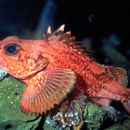ar
الأسماء في صفحات التنقل


Der Langstachelige Stachelkopf (Sebastolobus altivelis), englisch Longspine thornyhead, ist ein Meeresfisch in der Familie der Stachelköpfe. Er kommt an der Pazifikküste Nordamerikas vom Süden Kaliforniens bis nach Alaska und den Aleuten vor.
Der Fisch ist auffällig rot gefärbt, Jungfische unter 5 Zentimeter sind schwarz, und kann bis zu 39 Zentimeter groß werden; üblich sind Größen um 30 Zentimeter. Das maximal bekannte Alter liegt bei 45 Jahren.[1]
Die Rückenflosse hat normalerweise 15, manchmal auch 16 Flossenstacheln und 8 bis 10 Weichstrahlen. Die Flossenstacheln sind ungiftig. Die Afterflosse wird von drei Stacheln und 4 bis 6 Weichstrahlen gestützt. Die Schwanzflosse ist abgerundet, die Brustflossen sind eingebuchtet. Der Kopfstacheln sind sehr stark.
Der Langstachelige Stachelkopf lebt bodennah auf Weichböden in einer Tiefe von 370 bis 1600 Metern. Er hat sich dem hohen Druck, dem geringen Sauerstoffgehalt des Wassers und dem geringen Nahrungsangebot mit einem verlangsamten Stoffwechsel angepasst; der Fisch kann so bis zu 180 Tage ohne Nahrung überleben. Allgemein ernährt er sich u. a. von Krill, Schlangensternen und anderen niederen Lebensformen, die auf dem Tiefseeboden vorkommen. Es kommt aber auch Kannibalismus vor, d. h. große Fische jagen kleinere Exemplare.[2]
Der Fisch wird von größeren Tieren als Beute gejagt.
Weibliche Tiere erreichen mit ungefähr 23 Jahren die Geschlechtsreife und legen im Januar bis Mai etwa 2000-50.000 Eier.[3]
Der Langstachelige Stachelkopf wird in der Roten Liste des IUCN nicht aufgeführt, ist aber durch Überfischung und Grundschleppnetzfischerei gefährdet. In Kanada wird der Fisch gefangen und nach Japan exportiert, wo er als Delikatesse gilt. Von 1996 bis 2005 wurden in Kanada rund 6500 Tonnen gefischt.[2]
Der Langstachelige Stachelkopf (Sebastolobus altivelis), englisch Longspine thornyhead, ist ein Meeresfisch in der Familie der Stachelköpfe. Er kommt an der Pazifikküste Nordamerikas vom Süden Kaliforniens bis nach Alaska und den Aleuten vor.
Sebastolobus altivelis, the longspine thornyhead, is a species of marine ray-finned fish belonging to the subfamily Sebastinae, the rockfishes, part of the family Scorpaenidae. It is found in deep waters of the northeastern Pacific Ocean. Longspine thornyhead are similar in appearance to shortspine thornyhead though they don't grow as large and are typically found in deeper water.
Sebastolobus altivelis was first formally described in 1896 by the American ichthyologist Charles Henry Gilbert with the type locality given as being south of the Alaskan Peninsula at Albatross station 3338 at a depth 625 fathoms.[2] The specific name altivelis is a compound of altus which means "high" and velum meaning"sail", an allusion to the taller dorsal fin spines than S. macrochir.[3]
Sebastolobus altivelis has a moderately compressed, elongate body with a relatively large, pointed head,[4] The spiny head is armed with strong nasal, preocular, supraocular, postocular, tympanic, parietal and nuchal spines but there are no spines on the coronal. There are spines on a ridge on the sub-orbital bone.[1] It has large eyes which are closely set and sit on the top of the head with a depression between them. There is a single dorsal fin, clearly incised at the rear of the spiny part. There are 15–17, typically 15, strong, venomous spines and 8-9 soft rays. The third dorsal fin spine is much higher than the fourth. The anal fin has 3 spines, the second spine being the longest, and 4-6 soft rays 4–6.[4] The caudal fin has a square rear edge. The overall color is red to orange-red with white blotches on their back, cheeks, and the spiny part of the dorsal fin. They have dark colored gill chambers and black blotches on their flanks.[5] This species attains a maximum total length of 39 cm (15 in).[1]
Sebastolobus altivelisis native to the cold waters of the northeastern Pacific Ocean and is found from the Aleutian Islands, Alaska to southern Baja California, Mexico.[1] Its depth range is between 201 and 1,757 m (659 and 5,764 ft)[1] but it primarily occurs deeper than 600 metres (2,000 ft).[6] It is typically found over soft substrates biu may be found at the edges of reefs on harder substrates.[4]
Sebastolobus altivelis is a solitary species which typically lies motionless on the seabed for long periods of time. This species preys on other fish and invertebrates such as amphipods and shrimp. It is a long lived species which may live for up to 45 years.[5] Fertilization is internal and the females release the fertilized eggs in a floating, gelatinous mass in the Spring. The eggs hatch at the surface and the larvae and juveniles remain pelagic for up to 6 months. As the juveniles mature they gradually move into deeper waters although they usually remain at depths of around 600 m (2,000 ft), in the mesopelagic zone. After a year the young adults they settle. Juveniles feed on krill.[7]
Both shortspine and longspine thornyhead have been harvested in commercial fisheries with the period of peak catches occurring in the 1980s and 1990s.[6]
Separate stock assessments for longspine thornyhead in the waters off Alaska and the West Coast of the United States have estimated the stock as healthy (above the management limits) with overfishing not occurring.[6][8]
In the Canadian waters off the coast of British Columbia, a COSEWIC report declared the species a "special concern" based on the slow life history and declining trend in abundance, though no estimates of abundance or stock status were made.[7]
Sebastolobus altivelis, the longspine thornyhead, is a species of marine ray-finned fish belonging to the subfamily Sebastinae, the rockfishes, part of the family Scorpaenidae. It is found in deep waters of the northeastern Pacific Ocean. Longspine thornyhead are similar in appearance to shortspine thornyhead though they don't grow as large and are typically found in deeper water.
Sebastolobus altivelis Sebastolobus generoko animalia da. Arrainen barruko Sebastidae familian sailkatzen da.
Sebastolobus altivelis Sebastolobus generoko animalia da. Arrainen barruko Sebastidae familian sailkatzen da.
Sebastolobus altivelis is een straalvinnige vissensoort uit de familie van schorpioenvissen (Sebastidae).[1] De wetenschappelijke naam van de soort is voor het eerst geldig gepubliceerd in 1896 door Gilbert.
Bronnen, noten en/of referenties長棘鮶鮋,為輻鰭魚綱鮋形目鮋亞目平鮋科的其中一種,為深海魚類,分布於東太平洋阿留申群島至墨西哥下加利福尼亞南部海域,棲息深度201-1757公尺,體長可達39公分,棲息在軟底質底層水域,卵在漂浮的凝膠團,生活習性不明。
長棘鮶鮋,為輻鰭魚綱鮋形目鮋亞目平鮋科的其中一種,為深海魚類,分布於東太平洋阿留申群島至墨西哥下加利福尼亞南部海域,棲息深度201-1757公尺,體長可達39公分,棲息在軟底質底層水域,卵在漂浮的凝膠團,生活習性不明。